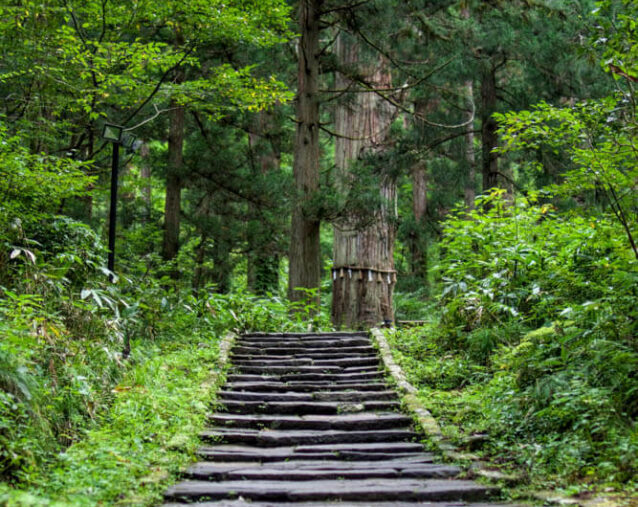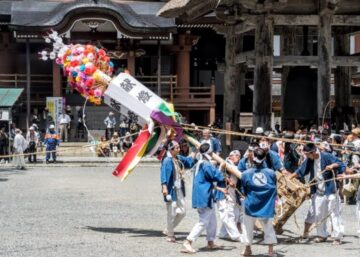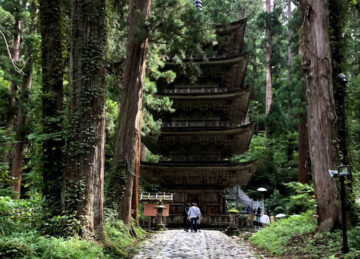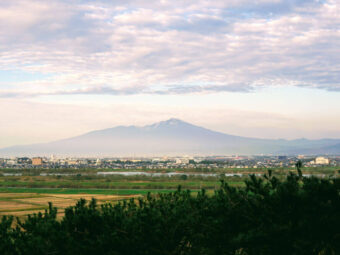Haguro-san
The
journey
begins
With its stone stairway and five-storied pagoda situated amongst the hundreds of towering cedar trees and Japan’s thickest thatched roof at Sanjingosaiden Shrine, the lowest-lying Mt. Haguro is the perfect initiation into the world of the Dewa Sanzan, the premiere location for spiritual rebirth.
Honji Buddha: Avalokiteśvara (Shokanseon-Bosatsu),
The Buddha of Worldly Benefits
Shinto Manifestations: Ideha-no-Kami, the Guardian Deity of Dewa Province, Ukanomitama-no-Mikoto, the Deity of Agriculture
Cosmic Time: The Present
Height: 414m (1358 ft.)
Open: Year-round
Daisendatsu and Yamabushi during the Hassaku Festival on Mt. Haguro
Sanjingosaiden Shrine at the top of Mt. Haguro
The Salvation of Hardship in the Present World
The three-legged crow is a messenger of the sun in Japanese mythology, just like the one that led Prince Hachiko, the revered founder of Haguro Shugendo, to Mt. Haguro. Mt. Haguro is also the location where Prince Hachiko came across the mountain's Honji Buddha, Avalokiteśvara, who is again represented as the sun. Over time, Mt. Haguro came to symbolise the world of the present in the Pilgrimage of Rebirth on the Dewa Sanzan.
The Pilgrimage Begins
Mt. Haguro marks the first and last stops on the pilgrimage of rebirth on the Dewa Sanzan. Traditional pilgrimages begin by first walking through the Zuishinmon gates and down the stone stairway, simulating walking into the depths of hell. After making the trip to Mt. Gassan (the past), and Mt. Yudono (the future), the pilgrimage ends by walking down the stone stairway on Mt. Haguro, then up the last section through the Zuishinmon gates once more, which represents the beginning of a new life.
The Stone Stairway on Mt. Haguro
What to see on Mt. Haguro
The 2,446-step Stone Stairway amongst the Cedars on Mt. Haguro
Stone Stairway
Cedar Forest
Take a step through the Zuishinmon gates on Mt. Haguro and you be instantly whisked away into another world. Mt. Haguro is famous for its line of cedar trees; hundreds of 300-500-year-old cedars that line the stone stairway; 2,446 steps all the way up to Dewa Sanzan Shrine at the top. Keep a look out for the many carvings on the steps, as its said that your every wish will be granted if you can find 33.
Massha Shrines
Dotted along the stone stairway up Mt. Haguro are the Massha shrines, each dedicated to a different Shinto god. The Massha shrines originally each housed a Buddha, which was appropriated to their Shinto God equivalent when Mt. Haguro switched to Shintoism during the Meiji Restoration.
Haraigawa River
Shinkyo Bridge
Located at the base of the first slope down Mt. Haguro, the Haraigawa River is the traditional spot for pilgrims to purify their bodies before making the ascent into the Dewa Sanzan. Crossing the Haraigawa River, the Shinkyo Bridge marks the traditional border into the sacred land, where women were not allowed to venture past until the switch to Shintoism during the Meiji Restoration (1868).
Suganotaki Falls
Grandfather Cedar
Visible from the Shinkyo bridge are the Suganotaki Falls that were formed when Tenyu Betto, the same 50th chief priest of Mt. Haguro, pulled water 8km from a river at the base of Mt. Gassan to flow into the Haraigawa river. Nearby lies the Grandfather Cedar, thought to be both the oldest at over 1000 years of age, and the tallest cedar on Mt. Haguro at 43m in height.
Suganotaki Falls and the Haraigawa River on Mt. Haguro
The Five-storied Pagoda constructed in 938
Five-Storied Pagoda
Where typically five-storied pagodas lie within temple grounds, the Five-storied Pagoda of Mt. Haguro is rare due to its location in the middle of a forest. Said to originally have been built by Samurai Taira no Masakado between 931 and 938, the current iteration is a rebuild completed in 1372 by then chief priest Daihoji Masuaji, making it the oldest tower in Tohoku.
Built deep in snow country, Mt. Haguro’s Five-storied Pagoda is the northernmost in Japan and each roof is the same size to help counteract the weight of the snow that accumulates yearly. The structure was built without a single nail nor coat of paint, and one less visible feature is the pillar running through the centre of the tower to mitigate damage in earthquakes, a characteristic also used in the construction of the Tokyo Sky Tree.
Ni-no-zaka Teahouse
Built on the grounds of a former temple, the Ni-no-zaka Teahouse commands excellent views out onto the Shonai plains, sometimes even to Tobishima Island off the coast of Shonai, or some of the coolest fog and cloud formations over a cedar forest that you will ever see.
Minamidani
Just before the third slope, there is a path off the stone stairway that veers to the right and leads to Minamidani, the southern valley. This is the location of the remains of Shionji Temple where Japan’s most prominent Haiku poet, Matsuo Basho, stayed for four nights during his trip writing The Narrow Road to the Deep North.
Torii gates at the top of Mt. Haguro
Sanjin-gosaiden Shrine boasts the thickest thatched roof in Japan
Saikan
Saikan has provided lodging and supplies to pilgrims on the Dewa Sanzan for centuries. A former temple built in 1698 named Kezoin, the building came under the control of Dewa Sanzan Shrine during the Meiji Restoration, one of only three temples to survive the destruction of Buddhist artefacts at the time. Saikan is known for its Shojin Ryori Ascetic Cuisine based solely on mountain vegetables, and as the host of the two Matsuhijiri Yamabushi during their 100-day Fuyu-no-mine Winter Peak ritual that concludes at the Shoreisai Festival on New Year’s Eve.
Sanjin-gosaiden Shrine
Sanjin-gosaiden Shrine at the top of Mt. Haguro was originally built in appreciation to Prince Hachiko for using his special Yamabushi powers to heal the governor’s mother. All three gods of the Dewa Sanzan are enshrined here when Mt. Gassan and Mt. Yudono are closed for the winter. Built in 1818, the mostly-cedar structure has a 2.1m-thick thatched roof, the thickest in Japan, and was designated as a national tangible cultural property in 2000.
Shukubo
Pilgrim Lodges
A trip to the Dewa Sanzan would not be complete without staying in one of the Shukubo pilgrim lodges of Toge Village. Purposely built to host the millions of pilgrims that ventured to the sacred peaks annually, Shukubo devotedly provide pilgrims with Shojin Ryori ascetic cuisine, the white Shiroshozoku garments for Yamabushi mountain monk training, and Sendatsu mountain guides, in addition to lodging.
What makes the Shukubo unique is their dedicated altar for rituals, the Shojin Ryori recipes passed down through the generations, and the Shime ropes that represent sacred areas. Each Shukubo was originally designated a specific area in Japan to play host to, yet these days this is only loosely followed. More than 300 Shukubo lined the streets during the Dewa Sanzan’s heyday in the 1600s, however these days the number has dwindled to less than 30, making for a truly rare experience.
Daishinbo Shukubo of Toge Village at the base of Mt. Haguro
The mountain-vegetable-based Shojin Ryori of the Dewa Sanzan
Shojin Ryori
Ascetic Cuisine
Shojin Ryori (ascetic cuisine) of the Dewa Sanzan developed through what Yamabushi ate for survival during training in the mountains, such as roots, nuts, or even flowers. The ingredients were first eaten raw, then heated, and then preserved using techniques such as salting, drying, or pickling, that last to this day.
Believing Shojin Ryori could give them special powers, more and more people wanted to copy what the Yamabushi were eating so the Shukubo began to provide more substantial meals for the pilgrims. Each Shukubo then developed their own variations of the dishes, such as sesame tofu, that have been passed down through the generations.
Shojin Ryori of the Dewa Sanzan was one major reason why Tsuruoka was certified as a UNESCO Creative City of Gastronomy in 2014.
Experiences on Mt. Haguro
Hiking Routes
Learn all you need to know before and during a hike on the Dewa Sanzan.
Access Mt. Haguro
Mt. Haguro by Bus
The bus to the bottom of Mt. Haguro from Tsuruoka Station costs ¥820 and takes about 40 minutes. Eight services run every day of the year: 7:52, 9:42*, 10:42, 11:42*, 12:57, 14:32, 15:52, with the last bus is at 17:27.
If you’re staying in a Shukubo, most likely you will want to stop somewhere before Haguro Zuishinmon. Daishinbo and Daishobo are closest to Sakura Koji. Most of these busses go all the way to the top of Mt. Haguro, called Haguro Sancho, where Sanjingosaiden (Dewa Sanzan Shrine) and Saikan are.
This is also where the Dewa Sanzan Flower Festival and Hassaku Festival take place. If you're going to the top, it costs ¥1,210 and take 50 minutes from Tsuruoka Station (10 minutes from the base). Be warned that the 17:27 bus only goes to the Shukubo village and Zuishinmon at the base of Mt. Haguro. If you wish to take a bus to the top, you will need to catch the 15:52, or take a taxi.
Extra Busses
However, there are extra bus services that run in the mornings when the bus service to Mt. Gassan 8th Station is on. These busses run through all of July and August, and on selected dates in September (see here for more details). These busses leave Tsuruoka Station at 6:02 and 7:02.
In addition, there are busses that only run on weekdays excluding the 31st of December. These busses leave Tsuruoka station at 13:32 and 18:37. Be warned that the 18:37 only takes you to Zuishinmon at the bottom of Mt. Haguro. More information for busses between Tsuruoka Station and Mt. Haguro and Mt. Gassan can be found here.
*The 9:42 and 11:42 don't go all the way to the top of Mt. Haguro between November and March.
Mt. Haguro by car
By far the easiest way to visit Mt. Haguro is by private or rental car. To enjoy the hike, park at Ideha Cultural Memorial Hall near the Zuishinmon gates. If you aren't much of a hiker, we still recommend checking out the Five Story Pagoda at the base, about 800m from the Zuishinmon gates. Then, drive to the top using the ¥400 toll road to check out Sanjingosaiden and the other shrines.
Mt. Haguro by bike
It is also possible to reach Mt. Haguro by bike, however bikes aren't allowed on the toll road. It would be best to bike to the Zuishinmon and then walk up.
Accessing the Dewa Sanzan
Learn all about the best ways to access the Dewa Sanzan with our Ultimate Guide to Accessing the Dewa Sanzan article.
The Journey Continues
The Pilgrimage of Rebirth continues with a trip to the world of the afterlife on Mt. Gassan, before visiting the world of the future on Mt. Yudono.
Insider information and updates on
The Dewa Sanzan.
Subscribe to the Dewa Sanzan Tribe now.











